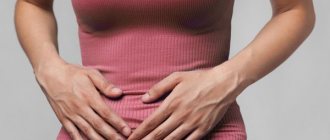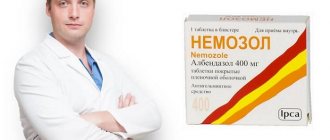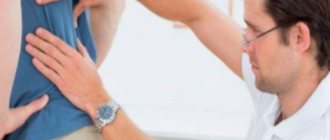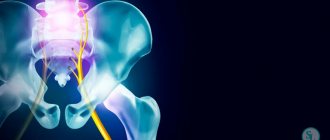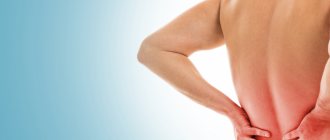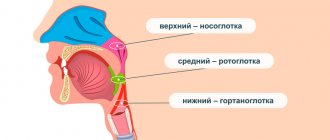Causes and mechanism of development of osteochondrosis
To understand why your back hurts, you need to understand how our spine is structured, how it works, what functions it performs and what factors can lead to its damage.
The human spine consists of 32-34 vertebrae (7 cervical, 12 thoracic, 5 lumbar, 5 sacral, 3-5 coccygeal), between which there is an intervertebral disc consisting of cartilage tissue. In the middle of the intervertebral disc there is the nucleus pulposus - a semi-liquid formation in the form of a “ball”, which performs the function of shock absorption and is surrounded by dense cartilage tissue (fibrous ring). The spinal canal, which contains the spinal cord and the nerves extending from it, runs through the entire spine. This entire structure is surrounded by muscles and ligaments. The main functions of the spine are musculoskeletal, shock-absorbing, and protective.
Imagine the Ostankino TV tower, which is held in a vertical position thanks to a whole system of cables stretched from the base to the top. Likewise, our spine is held in the desired position by a group of stabilizer muscles, which normally evenly distribute the load on the spine and joints. Unlike the Ostankino TV tower, our spine is more complex; it can bend in different directions and even twist, all this is possible due to the presence of an intervertebral disc, muscles and ligaments.
Every day a person makes some monotonous, repetitive movements associated with work or leisure activities. If the same muscles work for a long time, they become overstrained and spasm, while other muscles at this time do not experience any stress at all and atrophy. This leads to a change in the “geometry” of the body, the load on the intervertebral disc is redistributed, spasmed muscles tighten the vertebrae, and nutrition deteriorates. With monotonous hard physical labor, the same processes occur. In addition, the intervertebral disc does not have blood vessels, and its nutrition is provided by the surrounding muscles, and during movement in the intervertebral joint, nutritious synovial fluid enters it.
Cartilage tissue consists of 80-85% water, so the drinking regime is of great importance. During the day, a person should drink at least 2 liters of clean water. If not enough water enters the body, then dehydration (drying out) of the intervertebral disc occurs, the cartilage cracks and collapses.
In my practice, I have long noted that stress, anxiety, and worries often contribute to the occurrence of back pain. Our body perceives any stressful situation as danger. At the same time, the sympathetic part of the nervous system is activated, the adrenal glands “inject” stress hormones into the blood, blood pressure rises, the heartbeat quickens, and muscles tense. In nature, if an animal is frightened of something, it runs or defends itself, accordingly, stress hormones burn and the muscles, after working, relax. Man is a social being; he begins to worry more often and move less, so there is no relaxation. As a result, pain in the spine, headache, motor tics and more occurs.
In the literature you can find different formulations of osteochondrosis, but their essence is the same. Osteochondrosis is a “breakdown” of the motor segment, destruction, degeneration of cartilage tissue. The reason is an incorrect motor stereotype and, as a consequence, a malnutrition of the cartilage.
The progression of osteochondrosis is promoted by: a sedentary lifestyle, heavy physical activity, heavy lifting, obesity, carrying a bag on one shoulder, high-heeled shoes, too soft a mattress for sleeping, frequent hypothermia, bad habits, hereditary predisposition, stressful situations, insufficient drinking regime and other.
general characteristics
Osteochondrosis is a degenerative disease of the spine, which most often affects the thoracic, lumbar and cervical regions. This pathology has a direct correlation with age. The disease is much more common in people over 40 years of age, but recently there has been a trend towards rejuvenation. Common osteochondrosis differs in that it affects more than one section of a department or several departments at once. Due to the progressive development of degenerative processes not only in bone tissue, but also in the ligamentous apparatus of the spine, the vertebrae become mobile and put pressure on the nerves and blood vessels. The symptoms of common osteochondrosis are associated with this, but it is noteworthy that the disease can be asymptomatic for some time.
Common osteochondrosis is a pathology that affects several areas of one part of the spine or several parts at once.
Important! The pathology requires multidisciplinary control, since it affects not only the musculoskeletal system, but also the nervous system, as well as internal organs. In addition to the spine itself, the pathological process can also affect other elements of the skeleton.
Symptoms of osteochondrosis
Manifestations of osteochondrosis will depend on the location and severity of the lesion in the spinal motion segment. At the initial stage, patients complain of dull, aching back pain, discomfort, slight limitation of movements in the spine, periodic numbness in the arms or legs, headache, and fatigue. By starting treatment and changing your lifestyle during this period, the result will not be long in coming and recovery will come quickly.
With severe damage to the intervertebral disc, severe pain, persistent numbness and/or weakness in the arm or leg occurs (depending on the level of damage). These signs may indicate destruction of the intervertebral disc and the presence of a hernia, and it is necessary to immediately consult a doctor and begin treatment.
In the most severe cases, the pain syndrome can be extremely severe, possible dysfunction of the pelvic organs, severe weakness and numbness in the arm or leg. If these signs are present, urgent hospitalization in a hospital is necessary to resolve the issue of surgical treatment.
With cervical osteochondrosis, pain occurs in the neck, can radiate to the shoulder, arm or head, numbness or weakness in the arm, headache, dizziness.
With osteochondrosis of the thoracic spine, pain occurs in the chest, radiates to the sternum or scapula, intensifies with breathing and movement, and sometimes there is a feeling of lack of air. Patients often confuse this condition with heart pain.
When the lumbosacral spine is affected, the pain is localized in the lower back, intensifies with movement, radiates to the leg or perineum, and numbness or weakness in the leg may occur.
It is necessary to remember that our body is a single whole, and the division of osteochondrosis into cervical, thoracic, and lumbar is arbitrary. As a rule, the disease develops throughout the spine, but manifests itself in the part that experiences the greatest load.
Diagnostics
When visiting a doctor, the diagnosis will consist of several components. The first and most important is the collection of anamnesis based on subjective information given by the patient. Attention is paid to family history, since osteochondrosis has a genetic component. The specialist asks about the place of work, living conditions and the course of the disease itself, and the patient must describe exactly what is bothering him. The best results can be achieved with good feedback between the patient and the doctor.
The next method is an objective study, which is carried out by a specialist himself or using instrumental methods. The doctor checks the range of motion of the neck and limbs, which may be noticeably reduced due to pain and stiffness. Using the palpation method, he records how much the muscles are undergoing spasms and how curved the spine is. Attention is drawn to a neurological examination, with the help of which weakened reflexes can be traced. This symptom may be the result of compression or damage to the nerve.
The disease is diagnosed using MRI, X-ray, myelogram and other methods
Instrumental methods for diagnosing common osteochondrosis include:
- X-ray of the entire spine in two projections.
- MRI to evaluate ligaments and nerve tissue.
- An electrophysiological study to test the conduction of nerve impulses.
X-ray is effective for determining the presence of bone growths - osteophytes, narrowing of the spinal canal and the presence of other diseases that are a consequence of osteochondrosis, for example, scoliosis.
Computed tomography can also be used in conjunction with MRI. Using a CT scan, you can determine the degree of compression of the nerves by the spurs.
The diagnosis of widespread polysegmental osteochondrosis is made if other pathologies that cause destruction of the vertebrae (for example, tuberculosis) have been excluded and if several segments of one or many departments are affected.
Secrets of traditional medicine
With osteochondrosis, not only official medicine helps, but also a variety of folk remedies. Warming and anti-inflammatory compresses, herbal decoctions, and various ointments have proven themselves to be quite effective.
Traditional medicine methods can contribute to better treatment of such pathology
A decoction of burdock (thistle) leaves is a good pain reliever. The compress can be left overnight.
Taking a warm bath with pine needle, knotweed and/or chamomile extract can help relax your muscles and reduce pain.
If you drink lilac tincture and/or a decoction of St. John's wort and burdock (thistle) roots, you can relieve pain.
Prevention of pathology
Exacerbations of osteochondrosis can be prevented by observing the following rules:
- properly organize work and rest;
- sit comfortably;
- lie and stand correctly;
- do not lift excessive weights.
To avoid such a disease, it is worth taking simple preventive measures.
Professional recommendations:
- You should not sit on soft ones. For sedentary work, a firm chair is required, the back of which reaches to the middle of the head. Moreover, the seat should be located at a height of 2/3 of the thigh length so that the legs are on the floor;
- You can’t slouch while sitting either;
- once every 15 minutes you need to change your position;
- for sleeping, use an orthopedic mattress or at least just a hard surface;
- if you have to carry heavy loads, load your arms equally;
- to lift weights, do not bend over, but squat down, while keeping your back straight;
- If possible, try to do self-massage.
How is a patient treated during an exacerbation?
Medicines for osteochondrosis
During an exacerbation, the most important thing is to relieve pain. This is usually expressed in injections of the necessary medications, since this is how the drugs are most digestible and effective. Later, when the symptoms become weak enough, the patient is given tablets.
It is necessary to treat exacerbation of neck osteochondrosis on time and as completely as possible. This is due to the fact that it is through the cervical spine that vital vessels and nerves pass, and inflammation can block them, which is fraught with very serious consequences.
Treatment
Treatment is based on the following mechanisms.
- Slowing down the degenerative process by improving the supply of nutrients to the structures of the musculoskeletal system.
- Spinal stabilization.
- Elimination of pinched nerve fibers.
- Relieving symptoms.
Treatment is mainly aimed at slowing the development of pathology and relieving symptoms
The following drugs are used for drug treatment:
- non-steroidal anti-inflammatory drugs that relieve inflammation and pain;
- anilides. For example, acetaminophen relieves pain in the initial stages;
- local analgesics in the form of ointments;
- muscle relaxants to reduce muscle spasm and increase range of motion;
- B vitamins to improve nerve tissue conductivity;
- chondroprotectors, which reduce the rate of progression of degenerative processes by integrating active substances (chondoitin sulfate and glucosamine) into cartilage cells. As a result, metabolism is normalized and clinical manifestations are reduced. The drug has been used for a long time and requires special consultation during pregnancy, lactation, and the presence of gastrointestinal diseases. An absolute contraindication is phenylketonuria;
- antispasmodics relieve spasms of smooth muscles and thereby alleviate the manifestations of osteochondrosis in internal organs;
- antioxidants;
- antidepressants to eliminate the psychosomatic component of this disease. They interfere with the transmission of nerve impulses from the central nervous system to the brain. Promote the production of endorphins and help solve the problem of chronic insomnia due to constant pain.
- neuropathic agents to eliminate damage to nerve endings.
- opiates for unbearable pain and ineffectiveness of other painkillers. For example, codeine, morphine.
The following are used as invasive medical procedures:
- injection of steroids into the epidural space. Steroids are powerful anti-inflammatory drugs. They relieve inflammation of the nerve roots, which helps relieve pain caused by radiculopathy. Complicated procedure. Requires a qualified specialist;
- injections into the facet joint. The injected drugs lead to local numbness and pain relief.
It is important to know! Taking medications is not intended to get rid of the disease - there are no medications that could completely eliminate osteochondrosis, which is a chronic disease. Drugs are prescribed only to relieve symptoms.
The table below lists some recommended medications, how they work and dosage.
Table No. 2. Medicines for common osteochondrosis.
